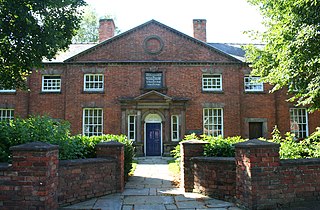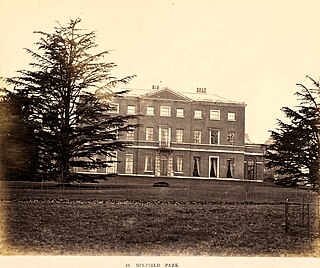
Harwell is a village and civil parish in the Vale of White Horse about 2 miles (3 km) west of Didcot, 6 miles (10 km) east of Wantage and 13 miles (21 km) south of Oxford. The parish measures about 3.5 miles (6 km) north – south, and almost 2 miles (3 km) east – west at its widest point. In 1923 its area was 2,521 acres (1,020 ha). Historically in Berkshire, it has been administered as part of Oxfordshire, England, since the 1974 boundary changes. The parish includes part of Harwell Science and Innovation Campus in the southwest. The 2011 census recorded the parish's population as 2,349.

Bucklebury is a village and civil parish in West Berkshire, England, about 5 miles (8 km) north-east of Newbury and 1–3 miles (1.6–4.8 km) north of the A4 road. The parish has a population of 2,116, but the village is much smaller. Bucklebury Common, with an area of over 1 square kilometre (0.39 sq mi), is one of the largest commons in the ceremonial and historic county of Berkshire.

Hurst is a village in the civil parish of St Nicholas Hurst in the Borough of Wokingham, Berkshire, England. The village lies between Twyford and Wokingham, about 1.5 miles (2.4 km) north of the M4 motorway.

Chirton is a village and civil parish in Wiltshire, England, on the southern edge of the Vale of Pewsey about 5 miles (8 km) south-east of Devizes. The parish includes the hamlet of Conock, about half a mile west of Chirton village.

Froxfield is a village and civil parish in the English county of Wiltshire. The parish is on the Wiltshire-West Berkshire border, and the village lies on the A4 national route about 2.5 miles (4 km) west of Hungerford and 7 miles (11 km) east of Marlborough.

Montagu House was a late 17th-century mansion in Great Russell Street in the Bloomsbury district of London, which became the first home of the British Museum. The first house on the site was destroyed by fire in 1686. The rebuilt house was sold to the British Museum in 1759, and demolished in the 1840s to make way for the present larger building.

Eastbury Manor House is a Grade I listed building situated in the London Borough of Barking and Dagenham in Greater London, England. It dates to the Elizabethan period, although the land on which it was built was formerly part of the demesne of Barking Abbey. The house is owned by the National Trust but has been managed since the 1930s by the London Borough of Barking and Dagenham and its predecessors. It is open to the public for 10 months of every year.

Beckett Hall is a country house at Shrivenham in the English county of Oxfordshire. The present house dates from 1831.

Clayton Hall is a 15th-century manor house on Ashton New Road in Clayton, Manchester, England, hidden behind trees in a small park. The hall is a Grade II* listed building, the mound on which it is built is a scheduled ancient monument, and a rare example of a medieval moated site. The hall is surrounded by a moat, making an island 66 by 74 metres. Alterations were made to the hall in the 16th and 17th centuries, and it was enlarged in the 18th century.

Crewe Almshouses or Crewe's Almshouses is a terrace of seven former almshouses at the end of Beam Street in Nantwich, Cheshire, England. The present building was erected in 1767 by John Crewe, later first Baron Crewe, and is listed at grade II. It has a central projecting section topped by a pediment, with a stone doorway flanked with Tuscan columns. The present almshouses stand on the site of a 16th-century building, originally the mansion of the Mainwaring family and later the town's House of Correction and workhouse.

Wright's Almshouses is a terrace of six former almshouses now located on Beam Street in Nantwich, Cheshire, England. The building was originally erected at the junction of Hospital Street and London Road in 1638 by Edmund Wright, Lord Mayor of London in 1640–41, and is listed at grade II*. The low red-brick terrace has stone dressings and a central stone panel with arms. The adjacent stone archway of 1667, which Nikolaus Pevsner describes as the "best" feature of the almshouses, is also listed separately at grade II*, together with its associated wall.

The Wilbraham's Almshouses, also known as the Wilbraham Almshouses, are six former almshouses in Nantwich, Cheshire, England, located on the north side of Welsh Row at numbers 112–116. Founded by Sir Roger Wilbraham in 1613, they were the town's earliest almshouses. They remained in use as almshouses until 1870, when they were replaced by the adjacent Tollemache Almshouses. The timber-framed building, which is listed at grade II, was subsequently used as a malthouse and as cottages, and was later considerably altered to form a single house. The Hospital of St Lawrence, a medieval house for lepers, might have been situated nearby.

The Widows' Almshouses, also known as the Wilbraham or Wilbraham's Almshouses and as the Widows' Hospital, are former almshouses for six widows in Nantwich, Cheshire, England. They are located at numbers 26–30 on the north side of Welsh Row, on the junction with Second Wood Street. The almshouses were founded by Roger Wilbraham in 1676–7 in memory of his deceased wife in three existing cottages built in 1637; they were the earliest almshouses in the town for women. In 1705, Wilbraham also founded the Old Maids' Almshouse for two old maids in a separate building on Welsh Row. They remained in use as almshouses until the 1930s. The timber-framed Widows' Almshouses building, which is listed at grade II, has subsequently been used as a café, public house, night club, restaurant, wine bar and hotel.
Betchton Hall is a country house in the parish of Betchton, Cheshire, England. It was originally a timber-framed house, and was substantially rebuilt in brick in the 18th century for Richard Jackson, prebendary of Chester. In the early years of the following century it was extended for Richard Galley. The house is in two storeys. The southeast front has seven bays that include a round-headed doorway. The southwest front has three bays, and contains Venetian windows. The entrance hall is circular. In the house is an 18th-century fireplace moved from Faringdon House, then in Berkshire and now in Oxfordshire, in the 1960s. The house is recorded in the National Heritage List for England as a designated Grade II listed building.

Lower Huxley Hall is a moated manor house in Cheshire, England, located about 6.5 miles (10 km) southeast of Chester. It lies roughly halfway between the villages of Huxley and Hargrave, It dates from the late 15th century, with major additions and alterations in the 17th century. A small addition was made to the rear in the 19th century. It was originally a courtyard house, but only two wings remain. The house is designated by English Heritage as a Grade II* listed building.

Gillows of Lancaster and London, also known as Gillow & Co., was an English furniture making firm based in Lancaster, Lancashire, and in London. It was founded around in Lancaster in about 1730 by Robert Gillow (1704–1772).
Comarques is an 18th-century country house in Thorpe-le-Soken, Essex, England. It has been attributed to the architect, Sir Robert Taylor. Named after Captain Comarque, a Huguenot refugee who owned the estate in the early 18th century, the house is in the Queen Anne style. The author Arnold Bennett lived at Comarques between 1913 and 1921. There is a tradition that Clement Attlee lived at the house as a child, but Historic England does not support this claim. Comarques is a Grade II* listed building.

The Admiralty buildings complex lies between Whitehall, Horse Guards Parade and The Mall and includes five inter-connected buildings.
Binfield Place is an English country house. It is a historic Grade II* listed building. The house is located at the west edge of Binfield, Berkshire.

Binfield Park is an English country house. It is a historic Grade II* listed building. The house is located just northeast of Binfield, Berkshire.


















